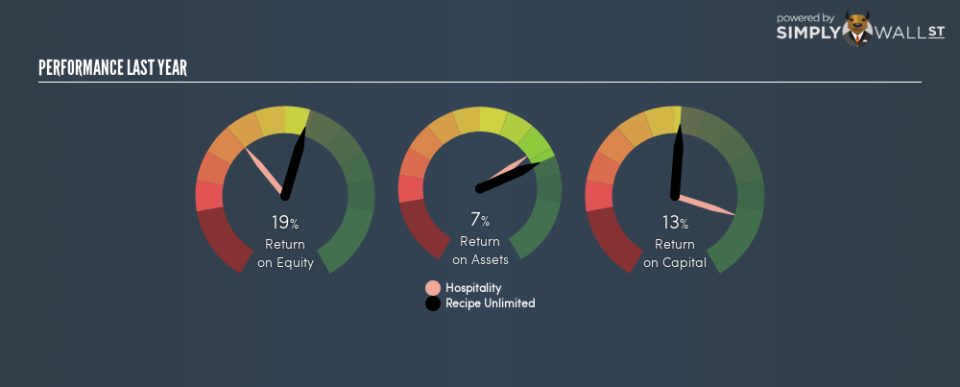Recipe Unlimited Corporation (TSE:RECP) Earns Among The Best Returns In Its Industry

Want to participate in a short research study? Help shape the future of investing tools and you could win a $250 gift card!
Today we’ll evaluate Recipe Unlimited Corporation (TSE:RECP) to determine whether it could have potential as an investment idea. To be precise, we’ll consider its Return On Capital Employed (ROCE), as that will inform our view of the quality of the business.
First up, we’ll look at what ROCE is and how we calculate it. Then we’ll compare its ROCE to similar companies. Last but not least, we’ll look at what impact its current liabilities have on its ROCE.
Return On Capital Employed (ROCE): What is it?
ROCE measures the ‘return’ (pre-tax profit) a company generates from capital employed in its business. All else being equal, a better business will have a higher ROCE. Ultimately, it is a useful but imperfect metric. Author Edwin Whiting says to be careful when comparing the ROCE of different businesses, since ‘No two businesses are exactly alike.’
How Do You Calculate Return On Capital Employed?
Analysts use this formula to calculate return on capital employed:
Return on Capital Employed = Earnings Before Interest and Tax (EBIT) ÷ (Total Assets – Current Liabilities)
Or for Recipe Unlimited:
0.13 = CA$140m ÷ (CA$1.6b – CA$370m) (Based on the trailing twelve months to September 2018.)
So, Recipe Unlimited has an ROCE of 13%.
View our latest analysis for Recipe Unlimited
Is Recipe Unlimited’s ROCE Good?
ROCE is commonly used for comparing the performance of similar businesses. Using our data, we find that Recipe Unlimited’s ROCE is meaningfully better than the 9.3% average in the Hospitality industry. We would consider this a positive, as it suggests it is using capital more effectively than other similar companies. Regardless of where Recipe Unlimited sits next to its industry, its ROCE in absolute terms appears satisfactory, and this company could be worth a closer look.
Recipe Unlimited’s current ROCE of 13% is lower than 3 years ago, when the company reported a 25% ROCE. This makes us wonder if the business is facing new challenges.
When considering ROCE, bear in mind that it reflects the past and does not necessarily predict the future. Companies in cyclical industries can be difficult to understand using ROCE, as returns typically look high during boom times, and low during busts. ROCE is only a point-in-time measure. Since the future is so important for investors, you should check out our free report on analyst forecasts for Recipe Unlimited.
Do Recipe Unlimited’s Current Liabilities Skew Its ROCE?
Liabilities, such as supplier bills and bank overdrafts, are referred to as current liabilities if they need to be paid within 12 months. Due to the way the ROCE equation works, having large bills due in the near term can make it look as though a company has less capital employed, and thus a higher ROCE than usual. To counteract this, we check if a company has high current liabilities, relative to its total assets.
Recipe Unlimited has total assets of CA$1.6b and current liabilities of CA$370m. Therefore its current liabilities are equivalent to approximately 24% of its total assets. Low current liabilities are not boosting the ROCE too much.
What We Can Learn From Recipe Unlimited’s ROCE
Overall, Recipe Unlimited has a decent ROCE and could be worthy of further research. You might be able to find a better buy than Recipe Unlimited. If you want a selection of possible winners, check out this free list of interesting companies that trade on a P/E below 20 (but have proven they can grow earnings).
For those who like to find winning investments this free list of growing companies with recent insider purchasing, could be just the ticket.
To help readers see past the short term volatility of the financial market, we aim to bring you a long-term focused research analysis purely driven by fundamental data. Note that our analysis does not factor in the latest price-sensitive company announcements.
The author is an independent contributor and at the time of publication had no position in the stocks mentioned. For errors that warrant correction please contact the editor at editorial-team@simplywallst.com.

 Yahoo Finance
Yahoo Finance 
